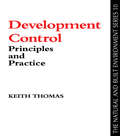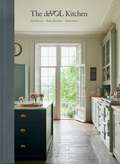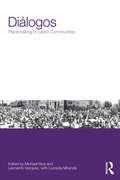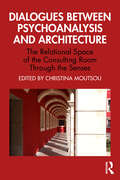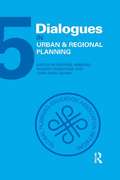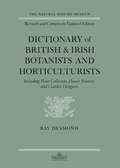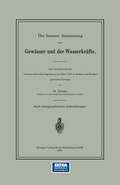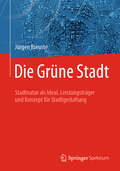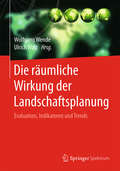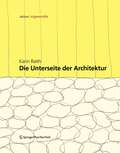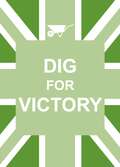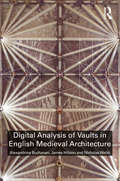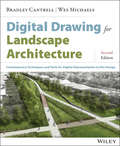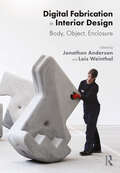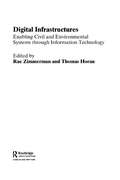- Table View
- List View
Development Control (Natural and Built Environment Series)
by Keith ThomasDevelopment Control" is a comprehensive introductory text for students of planning and related subjects. Drawing widely on the literature - the approach and treatment are very much geared to the needs of students on courses, rather than focusing on practical and "how-to-do-it" issues. It should be of interest to students in schools of planning, the built environment, estate management, land economy and other related subjects.
The deVOL Kitchen
by Paul O’Leary Helen Parker Robin McLellanA stunningly photographed guide to designing and styling the most used and important room in the home. Showcasing the philosophy and fundamentals of deVOL's iconic values, design principles and now widely recognised kitchen styling, this book is for anyone who values great design and beautiful styling and craftsmanship, for those looking for inspiration for their own kitchen project and everyone who has discovered deVOL's For The Love of Kitchens TV series.From total rebuilds to a more modest sink and cupboard upgrade, it will inspire you to design and style the space available to create a unique and stylish kitchen whatever your budget. Encouraging you to throw out the conventional rule book, draw your own plans and incorporate fitted and existing free-standing furniture and found objects to create a beautiful unique room that is perfect for your needs. With inspiration on how reorganise or elevate a current kitchen using colour, a single brass fitting, a decorated cupboard, a new light or piece of furniture to effortlessly style up for glamour or down for simplicity.Written by deVOL founder Paul O'Leary, inspirational Creative Director, Helen Parker and Robin McLellan and illustrated throughout with stunning photography of many of the unique kitchens and furniture deVOL have designed and made over the last 34 years, including The Real Shaker, The Classic English, The Sebastian Cox and the Haberdasher's Kitchens. Accompanied by the stories of the woodwork, ceramic and metal designers and makers and a styling and decorating guide by Helen Parker, deVOL's inspirational Creative Director.
Diálogos: Placemaking in Latino Communities
by Michael Rios Leonardo VazquezLatinos are one of the largest and fastest growing social groups in the United States, and their increased presence is profoundly shaping the character of urban, suburban, and rural places. This is a response to these developments and is the first book written for readers seeking to learn about, engage and plan with Latino communities. It considers how placemaking in marginalized communities sheds light on, and can inform, community-building practices of professionals and place dwellers alike. Diálogos: Placemaking in Latino Communities will help readers better understand the conflicts and challenges inherent in placemaking, and to make effective and sustainable choices for practice in an increasingly multi-ethnic world. The essays explore three aspects of place: the appropriation and territorialization of the built environment, the claiming of rights through collective action, and a sense of belonging through civic participation. The authors illustrate their ideas through case studies and explain the implications of their work for placemaking practice. A consistent theme about planning and design practice in Latino communities emerges throughout the book: placemaking happens with or without professional planners and designers. All of the essays in Diálogos demonstrate the need to not only imagine, build, and make places with local communities, but also to re-imagine how we practice democracy inclusive of cross-cultural exchange, understanding, and respect. This will require educators, students, and working professionals to incorporate the knowledge and skills of cultural competency into their everyday practices.
Diálogos: Placemaking in Latino Communities
by Michael Rios Leonardo Vazquez Lucrezia MirandaLatinos are one of the largest and fastest growing social groups in the United States, and their increased presence is profoundly shaping the character of urban, suburban, and rural places. This is a response to these developments and is the first book written for readers seeking to learn about, engage and plan with Latino communities. It considers how placemaking in marginalized communities sheds light on, and can inform, community-building practices of professionals and place dwellers alike. Diálogos: Placemaking in Latino Communities will help readers better understand the conflicts and challenges inherent in placemaking, and to make effective and sustainable choices for practice in an increasingly multi-ethnic world. The essays explore three aspects of place: the appropriation and territorialization of the built environment, the claiming of rights through collective action, and a sense of belonging through civic participation. The authors illustrate their ideas through case studies and explain the implications of their work for placemaking practice. A consistent theme about planning and design practice in Latino communities emerges throughout the book: placemaking happens with or without professional planners and designers. All of the essays in Diálogos demonstrate the need to not only imagine, build, and make places with local communities, but also to re-imagine how we practice democracy inclusive of cross-cultural exchange, understanding, and respect. This will require educators, students, and working professionals to incorporate the knowledge and skills of cultural competency into their everyday practices.
Dialogues between Psychoanalysis and Architecture: The Relational Space of the Consulting Room Through the Senses
by Christina MoutsouDialogues between Psychoanalysis and Architecture explores the multisensory space of therapy, real or virtual, and how important it is in providing the container for the therapeutic relationship and process. This book is highly original in bringing psychoanalysis and architecture together and highlighting how both disciplines strive to achieve transformation of our psychic space. It brings together contributions that comprise three parts: the first explores the space of the consulting room through the senses to examine issues such as smell and its link with memory and belonging, hearing out the Other, the psychoanalytic couch, the medical therapy room and the so-called sixth sense; secondly, the book questions how the consulting room can represent or be redesigned to reflect the philosophy that underlies the therapy process, foregrounding an architectural point of view; and thirdly, the book attends to the significance of the consulting room as a virtual space, as it emerged during the pandemic of COVID-19 and beyond. Architectural, psychotherapeutic and interdisciplinary perspectives allow for an important new dimension on the psychological use of space, and will appeal to psychoanalysts, psychoanalytic and integrative psychotherapists, art therapists, students of psychotherapy, as well as architects and designers.
Dialogues between Psychoanalysis and Architecture: The Relational Space of the Consulting Room Through the Senses
Dialogues between Psychoanalysis and Architecture explores the multisensory space of therapy, real or virtual, and how important it is in providing the container for the therapeutic relationship and process. This book is highly original in bringing psychoanalysis and architecture together and highlighting how both disciplines strive to achieve transformation of our psychic space. It brings together contributions that comprise three parts: the first explores the space of the consulting room through the senses to examine issues such as smell and its link with memory and belonging, hearing out the Other, the psychoanalytic couch, the medical therapy room and the so-called sixth sense; secondly, the book questions how the consulting room can represent or be redesigned to reflect the philosophy that underlies the therapy process, foregrounding an architectural point of view; and thirdly, the book attends to the significance of the consulting room as a virtual space, as it emerged during the pandemic of COVID-19 and beyond. Architectural, psychotherapeutic and interdisciplinary perspectives allow for an important new dimension on the psychological use of space, and will appeal to psychoanalysts, psychoanalytic and integrative psychotherapists, art therapists, students of psychotherapy, as well as architects and designers.
Dialogues in Urban and Regional Planning: Volume 5
by Michael Hibbard Robert Freestone Tore Øivin SagerDialogues in Urban and Regional Planning 5 is a selection of some of the best scholarship in urban and regional planning from around the world. The internationally recognized authors of these award-winning papers take up a range of salient issues from the theory and practice of planning. The topics they address include the effects of globalization on world cities, metropolitan planning in France and Australia, and new research in pedestrian and traffic design. The breadth of the topics covered in this book will appeal to all those with an interest in urban and regional planning, providing a springboard for further debate and research. The papers focus particularly on themes of inclusion, urban transformation, metropolitan planning, and urban design. The Dialogues in Urban and Regional Planning (DURP) book series is published in association with the Global Planning Education Association Network (GPEAN) and its member national and transnational planning schools associations.
Dialogues in Urban and Regional Planning: Volume 5
by Michael Hibbard Robert Freestone Tore Øivin SagerDialogues in Urban and Regional Planning 5 is a selection of some of the best scholarship in urban and regional planning from around the world. The internationally recognized authors of these award-winning papers take up a range of salient issues from the theory and practice of planning. The topics they address include the effects of globalization on world cities, metropolitan planning in France and Australia, and new research in pedestrian and traffic design. The breadth of the topics covered in this book will appeal to all those with an interest in urban and regional planning, providing a springboard for further debate and research. The papers focus particularly on themes of inclusion, urban transformation, metropolitan planning, and urban design. The Dialogues in Urban and Regional Planning (DURP) book series is published in association with the Global Planning Education Association Network (GPEAN) and its member national and transnational planning schools associations.
Dictionary Of British And Irish Botantists And Horticulturalists Including plant collectors, flower painters and garden designers
by Ray DesmondOver the past four centuries botanists and gardeners in the British Isles have gathered, maintained and propagated many varying species of plants. Their work has been documented in innumerable books and articles which are often difficult to trace. The Dictionary of British and Irish Botanists and Horticulturalists represents a time-saving reference source for those who wish to discover more about the lives and achievements of the horticulturalists listed. The dictionary's utility comes not only from indicating the major publications of the named authors, but also the location of their herbaria and manuscripts.; The previous 1977 edition of the Dictionary has for many years been a much used source of information for botanists, botanic artists and archivists. In this revised edition the scope has been expanded to include among its 13,000 entries flower painters in addition to botanical artists over 1400 entries and, for the first time, garden designers.; Finally the Dictionary should have international appeal since so many botanists and gardeners worked on collective plants overseas, in particular in North America and the British Commonwealth.; Each entry gives, wherever possible, details of dates and places of birth and death, educational qualifications, professional posts, honours and awards, publications, location of plant collections, manuscripts, drawings and portraits. Its main function, however, is to provide further biographical references to books and periodicals. Comprehensive classified indices facilitate access by professions and activities, countries, and plant interests.
Dictionary Of British And Irish Botantists And Horticulturalists Including plant collectors, flower painters and garden designers
by Ray DesmondOver the past four centuries botanists and gardeners in the British Isles have gathered, maintained and propagated many varying species of plants. Their work has been documented in innumerable books and articles which are often difficult to trace. The Dictionary of British and Irish Botanists and Horticulturalists represents a time-saving reference source for those who wish to discover more about the lives and achievements of the horticulturalists listed. The dictionary's utility comes not only from indicating the major publications of the named authors, but also the location of their herbaria and manuscripts.; The previous 1977 edition of the Dictionary has for many years been a much used source of information for botanists, botanic artists and archivists. In this revised edition the scope has been expanded to include among its 13,000 entries flower painters in addition to botanical artists over 1400 entries and, for the first time, garden designers.; Finally the Dictionary should have international appeal since so many botanists and gardeners worked on collective plants overseas, in particular in North America and the British Commonwealth.; Each entry gives, wherever possible, details of dates and places of birth and death, educational qualifications, professional posts, honours and awards, publications, location of plant collections, manuscripts, drawings and portraits. Its main function, however, is to provide further biographical references to books and periodicals. Comprehensive classified indices facilitate access by professions and activities, countries, and plant interests.
Die bessere Ausnutzung der Gewässer und der Wasserkräfte: Auf Veranlassung des Vereines deutscher Ingenieure im Jahre 1888 in Aachen und Breslau gehaltene Vorträge
by O. IntzeDie Grüne Stadt: Stadtnatur als Ideal, Leistungsträger und Konzept für Stadtgestaltung
by Jürgen BreusteDieses Lehrbuch zur Grünen Stadt untersucht Stadtnatur als Ideal, Leistungsträger und Konzept für Stadtgestaltung. Es beantwortet wichtige aktuelle Fragen, die sich zu den ökologischen und kulturellen Grundlagen, zur Entwicklung und Struktur und zum ökologischen Leistungsvermögen von Stadtnatur weltweit stellen. Das Buch erklärt, was Stadtnatur ist, wie sie entstand und wie sie sich im Kontext zu den natürlichen und kulturellen Bedingungen ihrer Standorte entwickelte. Zudem wird beschrieben, was urbane Biodiversität ausmacht und welche Rolle differenzierte Stadtnatur im Konzept der Grünen Stadt einnimmt. Theorien der Stadtentwicklung und Ökologie werden mit praktischen Anwendungen der Stadtplanung verbunden und mit vielen Fallstudien und Beispielen veranschaulicht. Die großen Potenziale von Stadtnatur werden im Detail aufgezeigt. Um Probleme in der Stadt zu bewältigen oder zu mildern, bedarf es eines zielgerichteten, an die besonderen Bedingungen der verschiedenen Stadtnatur-Arten angepassten Stadtnatur-Managements, das Naturschutz wie Naturgestaltung gleichermaßen einschließt und dabei immer den Bezug zu den Stadtbewohnern im Auge behält.Das Lehrbuch spricht besonders Studierende und Lehrende der Fächer Stadtplanung, Ökologie, Geographie, Sozialwissenschaften sowie Praktiker der Stadtgestaltung an.
Die Küche: Lebenswelt, Nutzung, Perspektiven (Living Concepts #1)
by Klaus SpechtenhauserDas Buch erschließt den Lesern die Küche als zentralen Wohnraum des häuslichen Lebens. Die Autorinnen und Autoren untersuchen die Küche – nachdem sie seit den 90er Jahren als modisch-repräsentatives Designobjekt ins Zentrum rückte – in Bezug auf ihre architektonischen, kulturellen, sozialen sowie ökonomischen Bedeutungen. Vorgestellt werden wichtige Entwicklungstendenzen und wegweisende Küchenkonzepte der letzten Jahrzehnte (Frankfurter Küche, Normküchen, Wohnküchen), planerische Grundlagen, aktuellste Trends, die sich wandelnden Bedürfnisse heutiger Benutzer an den Küchenraum (Patchworkfamilien, Singlehaushalte) sowie kulinarische Aspekte. Kurz: Ein Buch, das in keiner Küche des 21. Jahrhunderts fehlen sollte! Unsere neue Buchreihe Edition Wohnen stellt ausgewählte Themen aus dem weiten Feld des Wohnens kurz und übersichtlich vor. Sie richtet sich sowohl an allgemein kulturinteressierte Leserinnen und Leser als auch an Fachleute. Die Reihe wird herausgegeben vom ETH Wohnforum Zürich.
Die räumliche Wirkung der Landschaftsplanung: Evaluation, Indikatoren und Trends
by Wolfgang Wende Ulrich WalzDieses Buch befasst sich mit Leitfragen in der Landschaftsplanung. Aufgabe der Landschaftsplanung ist es, die im Bundesnaturschutzgesetz genannten Ziele des Naturschutzes und der Landschaftspflege in Deutschland umzusetzen. Derzeit erlebt die örtliche Landschaftsplanung eine Renaissance, da die Kommunen mit ihr unter anderem die Auswirkungen der Gewinnung erneuerbarer Energien und der Siedlungsentwicklung auf Natur und Landschaft mildern und steuern wollen. Doch wo genau steht die örtliche Landschaftsplanung in Deutschland heute eigentlich? Rund 75 % der Kommunen besitzen einen Landschaftsplan. Kann die Landschaftsplanung bereits Erfolge vorweisen? Wie war die bisherige Steuerungswirkung eines Landschaftsplans? Wo genau entfalten die Landschaftspläne auch tatsächlich räumliche Wirkung? Diese Leitfragen beschäftigt ein ausgewähltes Autorinnen- und Autorenteam der verschiedensten Forschungseinrichtungen in Deutschland. Sie evaluieren das Planungsinstrument, zeigen neueste Landschaftsindikatoren auf und analysieren Trends der Landschaftsentwicklung und -planung. Das Buch enthält eine Fülle von Abbildungen, Grafiken und Karten, die ebenfalls den Zustand und die Entwicklung von Landschaft in Deutschland dokumentieren.
Die Unterseite der Architektur: Konzepte und Konstruktionen an der Schnittstelle zwischen Kultur und Natur (Edition Angewandte)
by Karin RaithThema und Fragestellungen Dieses Buch handelt von der Beziehung zwischen Bauwerk und Boden. Der Ausgangspunkt der Untersuchung war die Beobachtung, dass Gebäude auf verschiedene Weise auf dem Baugrund ruhen, in ihn eingegraben sind, ihn durchdringen, sich über ihn erheben oder sich von ihm loslösen. Diese unt- schiedlichen Reaktionen auf den Baugrund manifestieren sich auf verschiedenen Maßstabsebenen, sowohl bei der Wahl und architektonischen Interpretation des Standortes eines Gebäudes und in der Ausformung des Baukörpers als auch im konstruk- ven und gestalterischen Detail. Die Architektur wird durch ihre räumlich-volumetrische Form in die geomorphologische Struktur der Landschaft eingeschrieben. Sie kann als eine Anpassung, Ergänzung oder eine Überhöhung, aber auch als Widerpart und Negation des Terrains in Erscheinung treten. Die Architektur tritt über einzelne spezialisierte Elemente mit dem Boden in direkte Verbindung: mit Fundamenten, Sockeln und Stützen, mit Kellergeschoßen, dem Unterbeton, mit Rollierungen, Abdichtungen und Dämmungen. Einige der Bauteile, die dafür verantwortlich sind, die Lasten vom Gebäude auf den Baugrund zu übertragen und Feuchtigkeit und Kälte von seinem Inneren fernzuhalten, erfüllen ihre Aufgaben still und verlässlich in der Tiefe des Baugrundes. Sie sind, sobald der Bauvorgang abgeschlossen ist, nicht mehr zu sehen. Sie haben konstruktiv einiges zu leisten, darüber hinaus aber nichts mitzuteilen oder darzustellen. Viel interessanter sind hingegen die Bauteile in der Zone, wo Architektur und Erdoberfläche sichtbar aufeinandertreffen. Der spannendste Topos der Konfrontation von Bau und Boden 11 sind die reale oder imaginäre Schnittlinie der Gebäudeoberfläche mit dem Gelände und das Kraftfeld, das diese Linieumgibt.
Dig For Victory
by Summersdale PublishersThe World War Two slogan is still pertinent in these thrifty times as more people than ever are turning to self-sufficiency and growing their own fruit and vegetables. This little compendium is packed with tips and hints on how to make the most of your garden along with witty quotations to help you dig for victory.
Digital Analysis of Vaults in English Medieval Architecture
by Alexandrina Buchanan James Hillson Nicholas WebbMedieval churches are one of the most remarkable creative and technical achievements in architectural history. The complex vaults spanning their vast interiors have fascinated both visitors and worshippers alike for over 900 years, prompting many to ask: ‘How did they do that?’ Yet very few original texts or drawings survive to explain the processes behind their design or construction. This book presents a ground-breaking new approach for analysing medieval vaulting using advanced digital technologies. Focusing on the intricately patterned rib vaulting of thirteenth and fourteenth century England, the authors re-examine a series of key sites within the history of Romanesque and Gothic Architecture, using extensive digital surveys to examine the geometries of the vaults and provide new insights into the design and construction practices of medieval masons. From the simple surfaces of eleventh-century groin vaults to the gravity-defying pendant vaults of the sixteenth century, they explore a wide range of questions including: How were medieval vaults conceived and constructed? How were ideas transferred between sites? What factors led to innovations? How can digital methods be used to enhance our understanding of medieval architectural design? Featuring over 200 high quality illustrations that bring the material and the methods used to life, Digital Analysis of Vaults in English Medieval Architecture is ideal reading for students, researchers and anyone with an interest in medieval architecture, construction history, architectural history and design, medieval geometry or digital heritage.
Digital Analysis of Vaults in English Medieval Architecture
by Alexandrina Buchanan James Hillson Nicholas WebbMedieval churches are one of the most remarkable creative and technical achievements in architectural history. The complex vaults spanning their vast interiors have fascinated both visitors and worshippers alike for over 900 years, prompting many to ask: ‘How did they do that?’ Yet very few original texts or drawings survive to explain the processes behind their design or construction. This book presents a ground-breaking new approach for analysing medieval vaulting using advanced digital technologies. Focusing on the intricately patterned rib vaulting of thirteenth and fourteenth century England, the authors re-examine a series of key sites within the history of Romanesque and Gothic Architecture, using extensive digital surveys to examine the geometries of the vaults and provide new insights into the design and construction practices of medieval masons. From the simple surfaces of eleventh-century groin vaults to the gravity-defying pendant vaults of the sixteenth century, they explore a wide range of questions including: How were medieval vaults conceived and constructed? How were ideas transferred between sites? What factors led to innovations? How can digital methods be used to enhance our understanding of medieval architectural design? Featuring over 200 high quality illustrations that bring the material and the methods used to life, Digital Analysis of Vaults in English Medieval Architecture is ideal reading for students, researchers and anyone with an interest in medieval architecture, construction history, architectural history and design, medieval geometry or digital heritage.
Digital Drawing for Landscape Architecture: Contemporary Techniques and Tools for Digital Representation in Site Design
by Bradley Cantrell Wes MichaelsCombine traditional techniques with modern media for more communicative renderings Digital Drawing for Landscape Architecture: Contemporary Techniques and Tools for Digital Representation in Site Design, Second Edition bridges the gap between traditional analog and new digital tools by applying timeless concepts of representation to enhance design work in digital media. The book explores specific techniques for creating landscape designs, including digitally rendered plans, perspectives, and diagrams, and the updated second edition offers expanded coverage of newer concepts and techniques. Readers will gain insight into the roles of different drawings, with a clear emphasis on presenting a solid understanding of how diagram, plan, section, elevation, and perspective work together to present a comprehensive design approach. Digital rendering is faster, more efficient, and more flexible than traditional rendering techniques, but the design principles and elements involved are still grounded in hand-rendering techniques. Digital Drawing for Landscape Architecture exploits both modalities to help designers create more beautiful, accurate, and communicative drawings in a professional studio environment. This second edition contains revised information on plan rendering techniques, camera matching workflow, and color selection, along with brand new features, like: Time-based imagery and tools Workflow integration techniques Photoshop and Illustrator task automation Over 400 updated images, plus over 50 new examples of award-winning work The book takes a tutorial-based approach to digital rendering, allowing readers to start practicing immediately and get up to speed quickly. Communication is a vital, but often overlooked component of the design process, and designers rely upon their drawings to translate concepts from idea to plan. Digital Drawing for Landscape Architecture provides the guidance landscape designers need to create their most communicative renderings yet.
Digital Drawing for Landscape Architecture: Contemporary Techniques and Tools for Digital Representation in Site Design
by Bradley Cantrell Wes MichaelsCombine traditional techniques with modern media for more communicative renderings Digital Drawing for Landscape Architecture: Contemporary Techniques and Tools for Digital Representation in Site Design, Second Edition bridges the gap between traditional analog and new digital tools by applying timeless concepts of representation to enhance design work in digital media. The book explores specific techniques for creating landscape designs, including digitally rendered plans, perspectives, and diagrams, and the updated second edition offers expanded coverage of newer concepts and techniques. Readers will gain insight into the roles of different drawings, with a clear emphasis on presenting a solid understanding of how diagram, plan, section, elevation, and perspective work together to present a comprehensive design approach. Digital rendering is faster, more efficient, and more flexible than traditional rendering techniques, but the design principles and elements involved are still grounded in hand-rendering techniques. Digital Drawing for Landscape Architecture exploits both modalities to help designers create more beautiful, accurate, and communicative drawings in a professional studio environment. This second edition contains revised information on plan rendering techniques, camera matching workflow, and color selection, along with brand new features, like: Time-based imagery and tools Workflow integration techniques Photoshop and Illustrator task automation Over 400 updated images, plus over 50 new examples of award-winning work The book takes a tutorial-based approach to digital rendering, allowing readers to start practicing immediately and get up to speed quickly. Communication is a vital, but often overlooked component of the design process, and designers rely upon their drawings to translate concepts from idea to plan. Digital Drawing for Landscape Architecture provides the guidance landscape designers need to create their most communicative renderings yet.
Digital Fabrication in Interior Design: Body, Object, Enclosure
by Jonathon Anderson Lois WeinthalDigital Fabrication in Interior Design: Body, Object, Enclosure draws together emerging topics of making that span primary forms of craftsmanship to digital fabrication in order to theoretically and practically analyze the innovative and interdisciplinary relationship between digital fabrication technology and interior design. The history of making in interior design is aligned with traditional crafts, but a parallel discourse with digital fabrication has yet to be made evident. This book repositions the praxis of experimental prototyping and integrated technology to show how the use of digital fabrication is inherent to the interior scales of body, objects and enclosure. These three scales act as a central theme to frame contributions that reinforce the interdisciplinary nature of interior design and reinterpret traditional crafts by integrating new methods of making into conventional workflows. Featuring significant international practitioners and researchers, the selected contributions represent the ever-increasing interdisciplinary nature of design, demonstrating a breadth of disciplines. A foundational text for interiors students and practitioners, Digital Fabrication in Interior Design expands the necessary dialogue about digital fabrication at the scale of interiors to inform design theory and practice.
Digital Fabrication in Interior Design: Body, Object, Enclosure
by Jonathon Anderson Lois WeinthalDigital Fabrication in Interior Design: Body, Object, Enclosure draws together emerging topics of making that span primary forms of craftsmanship to digital fabrication in order to theoretically and practically analyze the innovative and interdisciplinary relationship between digital fabrication technology and interior design. The history of making in interior design is aligned with traditional crafts, but a parallel discourse with digital fabrication has yet to be made evident. This book repositions the praxis of experimental prototyping and integrated technology to show how the use of digital fabrication is inherent to the interior scales of body, objects and enclosure. These three scales act as a central theme to frame contributions that reinforce the interdisciplinary nature of interior design and reinterpret traditional crafts by integrating new methods of making into conventional workflows. Featuring significant international practitioners and researchers, the selected contributions represent the ever-increasing interdisciplinary nature of design, demonstrating a breadth of disciplines. A foundational text for interiors students and practitioners, Digital Fabrication in Interior Design expands the necessary dialogue about digital fabrication at the scale of interiors to inform design theory and practice.
Digital Infrastructures: Enabling Civil and Environmental Systems through Information Technology (Networked Cities Series)
by Thomas Horan Rae ZimmermanAn invisible network of digital technology systems underlies the highly visible networks of roads, waterways, satellites, and power-lines. Increasingly, these systems are becoming the "infrastructure's infrastructure," providing a crucial array of data on network demand, performance, reliability, and security. Digital Infrastructures presents an interdisciplinary analysis of the technological systems that envelop these networks. The book balances analyses of specific civil and environmental infrastructures with broader policy and management issues, including the challenges of using IT to manage these critical systems under crises conditions.
Digital Infrastructures: Enabling Civil and Environmental Systems through Information Technology (Networked Cities Series)
by Rae Zimmerman Thomas HoranAn invisible network of digital technology systems underlies the highly visible networks of roads, waterways, satellites, and power-lines. Increasingly, these systems are becoming the "infrastructure's infrastructure," providing a crucial array of data on network demand, performance, reliability, and security. Digital Infrastructures presents an interdisciplinary analysis of the technological systems that envelop these networks. The book balances analyses of specific civil and environmental infrastructures with broader policy and management issues, including the challenges of using IT to manage these critical systems under crises conditions.
